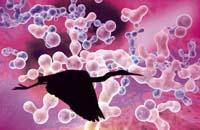Small genome for flying

In general, the genome of birds is smaller than that of mammals and reptiles. It seems this has to do with the ability to fly, but how? What is the cause and what is the consequence? Does flying make the genome smaller or fly because they had a small genome? Some paleontologists have found that the correct option is the second, that is, in evolution the genome was reduced before birds fly.
To find out, we analyzed the fossils of the birds' ancestors, some dinosaurs, which had a small or large genome that can be seen in their bones. The genome itself is not seen in fossils, but in the size of cells, and those of small genome develop small cells. In fact, in the fossils, they have seen that the ancestors of the birds had small cells. Furthermore, the cells were reduced at an evolutionary time, 60 million years before the appearance of birds. According to the scientists, in the ancestors of the birds, the repetitive parts of the genome disappeared, with which the cells were reduced.
The smaller the cells, the larger their surface is compared to the inside volume. This has a great influence on the activity of the cell membrane: the molecules enter and exit quickly from the cell, obtaining a rapid metabolism. All this is evident in the current birds, especially those that have not stopped flying. Ostriches, for example, have more genome than flying birds. It is clear that to fly you must have a light genome.





